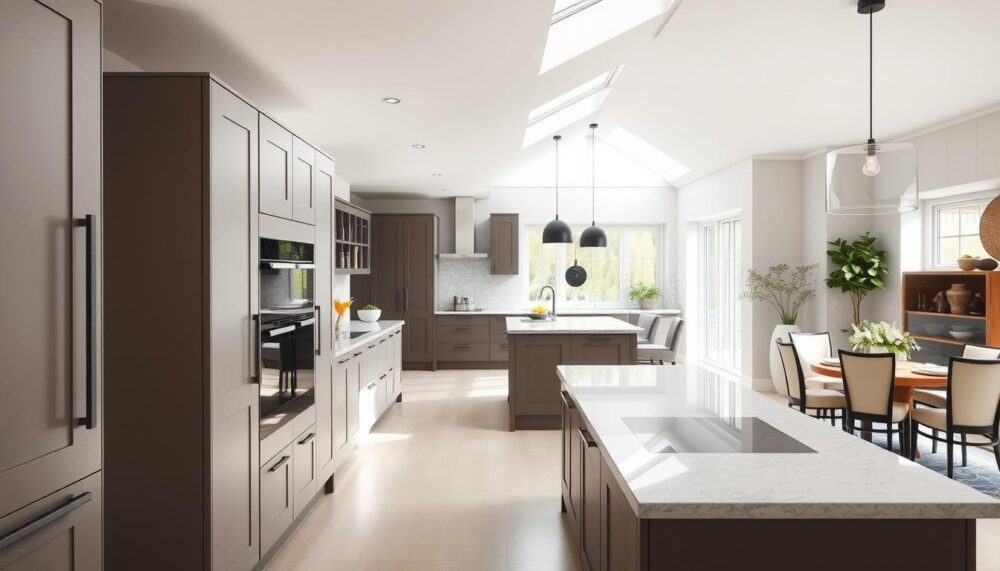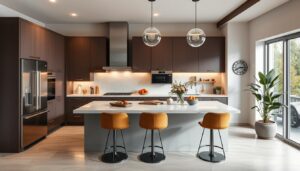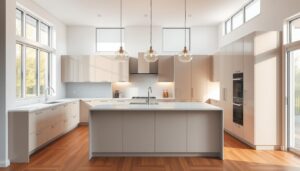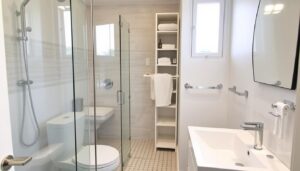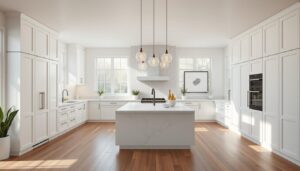In 2025, functional design will dominate the UK’s home improvement scene. With 94% of homes requiring modernisation, it’s crucial to approach renovations with care. Poor planning can lead to costly errors, diminishing both functionality and property value.
According to British Standard’s Will Eaves, material durability is a key factor in successful projects. Refresh Renovations’ 5-step process highlights the importance of professional consultation, layout planning, and budgeting. These elements ensure a smooth transformation of your space.
Smart planning not only enhances aesthetics but also boosts your home’s market appeal. Avoid common pitfalls by focusing on quality materials and expert advice. This approach guarantees a renovation that stands the test of time.
Key Takeaways
- Functional design is a top trend for 2025 renovations.
- Material durability is essential for long-lasting results.
- Professional consultation ensures a well-planned layout.
- Budgeting wisely prevents overspending.
- Smart planning increases property value.
1. Ignoring the Importance of Professional Design Consultation
Many homeowners underestimate the value of professional design consultation. While DIY projects can seem cost-effective, they often lead to costly mistakes. Expert advice ensures your vision aligns with practicality, creating a space that’s both beautiful and functional.
“Clients prioritise aesthetics over practicality, making it harder to change fixed units later.”
This underscores the importance of planning with aninterior designerwho understands spatial dynamics and material durability.
Why Professional Advice is Crucial
Professional services prevent structural errors that can derail your project. For instance, Alice Gaskell’s DIY lighting wiring oversight led to significant delays. A professional would have foreseen this issue, saving time and money.
Common Pitfalls of DIY Design
Refresh Renovations reports that 68% of DIY renovators regret layout decisions. Kaitlyn Coffee’s £1,500 fridge panel compromise is a prime example. Without expert guidance, her house’s functionality suffered, and the final result didn’t meet her expectations.
Investing in professional consultation can yield a 15-20% return on design fees. This ensures your house not only looks stunning but also serves your needs efficiently. Spatial planning, especially in UK terrace houses, is critical for achieving a harmonious balance between style and practicality.
2. Overlooking the Practicality of Materials
Selecting the right materials is pivotal for a successful home upgrade. While aesthetics often take centre stage, durability and practicality should guide your choices. Florrie Thomas faced a dilemma between porcelain and wood flooring, highlighting the importance of balancing beauty with functionality.
Choosing Aesthetics Over Durability
Many homeowners prioritise looks over longevity, leading to regrets. Sarah Srinivasan’s experience with Caesarstone countertops is a cautionary tale. She loved the initial appearance but soon realised the material required frequent maintenance. Stone surfaces like marble may look stunning, but they are prone to staining and scratching.
Wooden countertops, while warm and inviting, can warp in the UK’s humid climate. Recycled composites are emerging as a sustainable alternative, offering both durability and eco-friendliness. British Standard’s guide to wear-resistant surfaces emphasises the need for materials that withstand daily wear and tear.
Long-Term Maintenance Considerations
Maintenance costs vary significantly between materials. Quartz, for instance, is more durable and easier to maintain than marble. Unlacquered brass, often chosen for its vintage charm, requires regular polishing to retain its appeal. Below is a comparison of maintenance costs for popular materials:
| Material | Maintenance Cost (Annual) | Durability |
|---|---|---|
| Quartz | £50 | High |
| Marble | £150 | Medium |
| Wood | £100 | Low |
| Recycled Composites | £75 | High |
When planning your project, consider the long-term implications of your material choices. Investing in durable materials upfront can save you time and money in the future. Practicality should never be sacrificed for aesthetics.
3. Failing to Plan for Adequate Storage
Effective storage solutions are essential for maintaining a clutter-free and functional home. In the UK, where compact spaces are common, maximising every inch is crucial. Without proper planning, even the most stylish designs can fall short in practicality.
Maximising Cabinet Space
Reena Simon’s comparison of a 4m shelf versus floor-to-ceiling cabinets highlights the importance of vertical storage. Floor-to-ceiling units not only provide more storage but also make the most of limited space. Integrated appliance housing, such as pull-out larder units, offers a sleek alternative to traditional cupboards.
Patrick Williams’ Berdoulat Green drawer unit is a prime example of custom storage tailored to specific needs. Whether it’s a tea station or a breakfast hub, bespoke solutions ensure functionality without compromising on style.
Incorporating Smart Storage Solutions
Innovations from collaborations like IKEA and Naked Door have introduced space-saving designs that blend practicality with aesthetics. Pull-out shelving and modular units are particularly effective in smaller homes.
Clutter-free work surfaces not only enhance usability but also have a psychological impact, creating a sense of calm and order. Investing in smart storage solutions ensures your home remains organised and efficient for years to come.
4. Neglecting the Kitchen Layout
A well-thought-out layout is the backbone of any functional space. It ensures that every element works harmoniously, enhancing both function and aesthetics. Ignoring this crucial aspect can lead to inefficiencies and frustration.
The Importance of the Work Triangle
The work triangle, connecting the sink, hob, and fridge, remains a cornerstone of efficient design. However, modern appliances and larger spaces have updated its dimensions. For multi-cook households, a workflow analysis ensures smooth cooking experiences.
Issy Croker’s dishwasher placement fiasco highlights the need for careful planning. Her unit was too far from the sink, disrupting the workflow. This oversight could have been avoided with professional advice.
Common Layout Mistakes to Avoid
One frequent error is underestimating the space required for appliances. Natalie Sytner Yandell’s undersized island is a prime example. It looked stylish but lacked practicality, making it difficult to use.
Another mistake is ignoring UK safety regulations for appliance spacing. Proper clearance ensures safety and functionality. Galley layouts, while efficient in smaller homes, may not suit larger families. L-shaped designs, on the other hand, offer more flexibility.
Accessibility is another critical factor. The Equality Act 2010 mandates that spaces should be usable by everyone, including those with mobility challenges. Professional layout software can help visualise these considerations, ensuring a design that works for all.
5. Underestimating the Budget
Budgeting accurately is a cornerstone of any successful home improvement project. Many homeowners focus on aesthetics and functionality but overlook the financial aspects. This oversight can lead to unexpected expenses and project delays.
Hidden Costs in Home Renovations
Phoebe McDowell’s £2,000 tap replacement ordeal is a stark reminder of hidden costs. What seemed like a simple upgrade turned into a costly endeavour due to unforeseen plumbing issues. Such scenarios highlight the importance of planning for contingencies.
Twig Hutchinson’s electrical relocation costs further illustrate this point. Moving electrical points to accommodate a new layout added £1,500 to her budget. These examples underscore the need for a detailed financial plan.
How to Create a Realistic Budget
Start by accounting for material costs, which are projected to rise in 2025 due to inflation. Include a contingency fund of 15-20% to cover unexpected expenses. This buffer ensures you’re prepared for surprises without derailing your project.
Professional fees, such as those for architects and surveyors, should also be factored in. Refresh Renovations’ fixed-quote system offers transparency, helping homeowners avoid cost overruns. Additionally, explore finance options like personal loans or home equity to manage cash flow.
For period properties, consider VAT reclaim strategies. These can significantly reduce overall costs. By planning meticulously, you can transform your house without financial stress.
6. Choosing the Wrong Appliances
Appliances are the backbone of any modern home, yet many homeowners choose poorly. The right selection ensures efficiency, while the wrong one can lead to frustration and wasted resources. Florrie Thomas’ unused double oven conversion is a prime example of how mismatched appliances can fail to meet daily needs.
Matching Appliances to Your Lifestyle
Your appliances should align with your daily habits. For instance, a professional-grade cooker may seem appealing, but it’s unnecessary for casual cooking. Siobhan McFadden’s ventilation compromises highlight the importance of balancing power with practicality.
Consider these factors when choosing appliances:
- Built-in vs freestanding: Built-in units offer a sleek look but are costlier to install.
- Smart integration: Smart appliances add convenience but may pose compatibility challenges.
- Future-proofing: Induction technology is becoming a standard for energy efficiency.
Energy Efficiency and Sustainability
With 2025 UK energy efficiency regulations tightening, sustainable choices are essential. Induction hobs, for example, use less energy and heat up faster than traditional gas stoves. Recycling old appliances is also crucial—check local council regulations for proper disposal methods.
Here’s a quick comparison of energy-efficient options:
| Appliance | Energy Rating | Annual Cost |
|---|---|---|
| Induction Hob | A++ | £30 |
| Gas Hob | B | £50 |
| Electric Oven | A+ | £40 |
Choosing the right appliances enhances both function and design, ensuring your home remains efficient and stylish for years to come.
7. Overlooking Lighting Design
Lighting is often an afterthought in home upgrades, yet it plays a pivotal role in functionality and ambience. Poor lighting can make even the most beautifully designed space feel unwelcoming or impractical. Alice Gaskell’s disconnected under-cabinet wiring is a prime example of how overlooked lighting can disrupt a project.
Types of Lighting
Effective lighting design involves layering different types of illumination. Task lighting, such as under-cabinet LEDs, is essential for specific activities like cooking. British Standard BS 7671 outlines safety requirements for task lighting installations.
Ambient lighting, like ceiling fixtures, provides overall illumination. Accent lighting, such as spotlights, highlights architectural features or decor. Daisy Sims-Hilditch’s open shelving lighting demonstrates how accent lighting can elevate a space.
Creating a Balanced Lighting Scheme
A balanced lighting scheme ensures that every area of the room is well-lit without being overpowering. Dimmer switches allow flexibility, enabling you to adjust the brightness according to the time of day or activity.
Smart lighting control systems offer advanced customisation, allowing you to programme scenes or control lights remotely. These systems not only enhance convenience but also contribute to energy efficiency.
Here’s a comparison of LED strip and puck light options:
| Type | Cost | Benefits |
|---|---|---|
| LED Strip | £20-£50 | Flexible, even illumination |
| Puck Light | £10-£30 | Focused, bright light |
Energy-saving calculations show that LED conversions can reduce electricity bills by up to 80%. Investing in quality lighting not only enhances the design but also improves the functionality of your space.
8. Ignoring Ventilation Needs
Proper ventilation is often overlooked but is essential for a healthy and functional home. Without adequate airflow, issues like dampness, mould, and poor air quality can arise. Siobhan McFadden’s damp winter kitchen is a prime example of how neglecting ventilation can lead to long-term problems.
The Role of Extractor Fans
Extractor fans are a cornerstone of effective ventilation. UK building regulations mandate specific extraction rates to ensure air quality. For instance, a minimum of 60 litres per second is required for cooking areas. This prevents the buildup of grease and moisture, which can damage surfaces and affect health.
When choosing an extractor fan, consider noise levels. Downdraft systems are quieter, averaging 40 decibels, while ceiling-mounted units can reach 60 decibels. Galey Alix’s illuminated glassware vent solution demonstrates how extraction can be both functional and stylish.
Ventilation in Open-Plan Spaces
Open-plan designs pose unique ventilation challenges. Without walls to contain airflow, extractor fans must be strategically placed to ensure even distribution. Ducted systems are ideal for larger spaces, but they require regular maintenance to prevent blockages.
Integrating extraction with smart home systems adds convenience. For example, sensors can automatically activate fans when humidity levels rise. This not only enhances function but also improves energy efficiency.
Historic properties face additional hurdles. Retrofitting ventilation in listed buildings requires careful planning to preserve architectural integrity. Professional advice is crucial to balance modern needs with heritage conservation.
By addressing ventilation needs, you can create a space that is both comfortable and durable. Proper airflow enhances the design of your house while safeguarding its long-term value.
9. Not Considering the Worktop Depth
Worktop depth is a critical yet frequently overlooked aspect of functional design. Sarah Srinivasan’s cramped prep areas exemplify how insufficient depth disrupts daily tasks. Balancing aesthetics with practicality ensures seamless workflows.
Optimal Worktop Dimensions
The Chartered Institute of Ergonomics and Human Factors (CIEHF) recommends 600–650mm depths for comfortable use. Deeper countertops accommodate appliances like dishwashers, while shallower designs suit compact spaces.
Key considerations:
- Appliance integration: Built-in ovens require 600mm depths minimum.
- Overhang limits: Stone materials support 300mm overhangs; wood risks sagging beyond 250mm.
- UK standard height: 900mm (or 850mm for accessible designs).
Impact on Functionality and Aesthetics
Phoebe McDowell’s tap replacement woes stemmed from a 550mm worktop, forcing costly plumbing adjustments. Contrasting depths, like a 700mm baking zone beside 600mm prep areas, create intuitive zoning.
Stone surfaces demand weight-bearing calculations—20mm quartz needs support every 800mm. Clean lines and uniform depths enhance visual flow, but practicality must come first.
10. Skipping the Backsplash
Siobhan McFadden learned the hard way why backsplashes are non-negotiable. After completing her project, she faced stained walls and costly retrofits. A well-chosen backsplash blends design with practicality, shielding surfaces from spills and steam.
More Than Just a Pretty Wall
Backsplashes meet strict hygienic standards near cooking zones. They prevent grease buildup and simplify cleaning. Reena Simon’s patterned tile solution added personality while serving this dual purpose.
Integrated worktop upstands offer a seamless look, but traditional backsplashes allow more creative freedom. Consider these options:
- Glass: Low maintenance but prone to visible streaks.
- Ceramic tile: Durable and budget-friendly, though grout requires sealing.
- Metallic panels: Modern and heat-resistant, ideal near hobs.
Material Matters
UK waterproofing standards mandate moisture-resistant materials for wet areas. Near heat sources, opt for temperature-resistant options like stone or lacquered wood. Below is a quick comparison:
| Material | Maintenance | Best For |
|---|---|---|
| Porcelain | Wipe clean | High-splash zones |
| Stainless Steel | Polish weekly | Modern designs |
| Natural Stone | Seal annually | Heat-prone areas |
Daisy Sims-Hilditch’s lacquered oak backsplash proves even unconventional choices can work—if properly treated. Prioritise functionality, and your design will stand the test of time.
11. Misplacing Key Elements Like the Sink and Dishwasher
A misplaced sink or dishwasher can turn daily tasks into frustrating chores. Issy Croker’s experience of walking “laps of the room” to load her poorly positioned dishwasher underscores how poor planning disrupts function. Strategic placement is vital for a seamless workflow.
Efficient Placement for Workflow
The work triangle—connecting sink, hob, and fridge—remains a gold standard. Modern adaptations account for larger space and multiple users. Sarah Srinivasan’s “Tetris cupboard” dilemma, where her sink blocked cabinet access, highlights the need for precise measurements.
Consider these factors:
- Plumbing costs: Relocating pipes averages £800–£1,200 in the UK, depending on area.
- Waste pipe gradients: UK regulations require a 2.5° slope for proper drainage.
- Accessibility: The Equality Act 2010 mandates 1.5m clearance for wheelchair users.
Common Misplacement Errors
Dishwashers placed too far from sinks waste time and water. Soundproofing is often overlooked—units near living spaces should have noise levels below 50 decibels.
| Placement Issue | Cost to Fix | Solution |
|---|---|---|
| Sink too deep | £400–£600 | Adjust cabinet depth |
| Dishwasher far from plumbing | £1,000+ | Reroute pipes |
| Poor waste pipe angle | £200–£400 | Reinstall with correct gradient |
UK water pressure standards (1–3 bar) also impact appliance performance. Test pressure before finalising your layout to avoid costly adjustments later.
12. Overlooking the Importance of a Kitchen Island
A well-planned island can transform both the practicality and social appeal of your space. More than just stylish additions, they redefine workflows and gatherings. Autumn Pochiro’s 10x10ft island transformation demonstrates how strategic design elevates daily routines.
When to Include an Island
UK building regulations mandate minimum clearance distances—1m around islands for safe movement. Natalie Sytner Yandell’s undersized island (below 900mm wide) disrupted traffic flow, proving proportions matter. For smaller homes, mobile islands offer flexibility without permanent footprint costs.
“Islands demand careful weight distribution—20mm quartz requires support every 800mm to prevent sagging.”
Designing for Functionality and Style
Optimise storage with deep drawers or wine racks in island bases. Clean lines enhance visual flow, but prioritise ergonomics—breakfast bars should be 1.1m high for seated comfort. Electrical outlets must follow Part P regulations, ideally placed 150mm above worktops.
- Fixed vs. mobile: Fixed islands suit larger spaces; wheeled versions adapt to changing needs.
- Social zones: Overhangs (max 300mm for stone) create casual seating without compromising stability.
- Material pairing: Contrast countertop textures (e.g., wood and steel) add depth without clutter.
By balancing aesthetics with structural needs, your island becomes a hub for both cooking and connection. Measure twice, and it’ll serve you for decades.
13. Failing to Future-Proof the Kitchen
A home should evolve with its occupants, yet many designs remain static. Future-proofing ensures your space adapts to changing needs without costly alterations. Patrick Williams’ Berdoulat Green units showcase how flexible solutions can stand the test of time.
Designing for Changing Needs
Universal design principles make a home renovation accessible to all ages and abilities. Adjustable-height work surfaces, like those in Kaitlyn Coffee’s project, accommodate wheelchair users or growing children. Convertible storage transforms from spice racks to medication organisers as needs shift.
Smart home infrastructure is no longer optional. Pre-wiring for voice-controlled lighting or appliance hubs saves retrofitting costs later. Multi-generational households benefit from zoning—separate meal prep areas prevent congestion during busy mornings.
Incorporating Flexible Features
Modular units with interchangeable fronts allow style updates without structural changes. Consider these adaptable elements:
- Sliding panels: Conceal appliances or reveal open shelving as trends change
- Magnetic splashbacks: Swap decorative tiles without adhesive residue
- Plug-and-play islands: Relocate workstations as family dynamics evolve
Resale value hinges on timeless function. Neutral cabinetry with bold accent pieces appeals to broader markets. The table below compares popular adaptable features:
| Feature | Cost Range (£) | Lifespan |
|---|---|---|
| Adjustable shelving | 120–300 | 15+ years |
| Smart home wiring | 800–2,000 | 20+ years |
| Convertible worktops | 500–1,200 | 10–15 years |
“A kitchen should serve you for decades, not just suit today’s Pinterest trends.”
Investing 10–15% more upfront in adaptable design yields long-term savings. As UK households shrink and expand unpredictably, flexibility becomes the ultimate luxury.
14. Ignoring the Impact of Colour and Finish
The right hues and surfaces can elevate a design while standing the test of time. In 2025, UK trends shift toward earthy tones and low-maintenance finishes. Mark Anthony Fox’s stainless steel upkeep conflict proves that even sleek materials demand careful consideration.
Choosing Timeless Colours
Christopher Boutlioer’s olive-toned island demonstrates how bold colour choices can remain relevant. British homeowners increasingly favour:
- Neutrals: Warm greys and muted greens for versatility
- Accent walls: Deep blues or terracotta for focal points
- UV-resistant paints: Critical for south-facing walls
“Evolving lifestyles demand colours that adapt—think convertible palettes for multi-use spaces.”
The Role of Finish in Longevity
Finish quality dictates how well surfaces endure daily life. Laminate resists scratches but lacks depth, while painted cabinets require touch-ups every 3–5 years. Compare options below:
| Finish Type | Durability | Maintenance |
|---|---|---|
| High-gloss paint | 5–7 years | Annual cleaning |
| Matte laminate | 10+ years | Wipe only |
| Textured stone | 15+ years | Seal biannually |
Psychological studies reveal matte finishes reduce visual clutter, enhancing calm. For a cohesive style, pair fixed elements like countertops with changeable accents like cabinet handles.
15. Not Planning for Electrical Outlets
Twig Hutchinson’s breakfast station dilemma highlights how electrical oversights disrupt daily routines. What began as a convenient coffee nook became a tangled mess of extension leads. Proper outlet planning ensures your space remains both beautiful and functional.
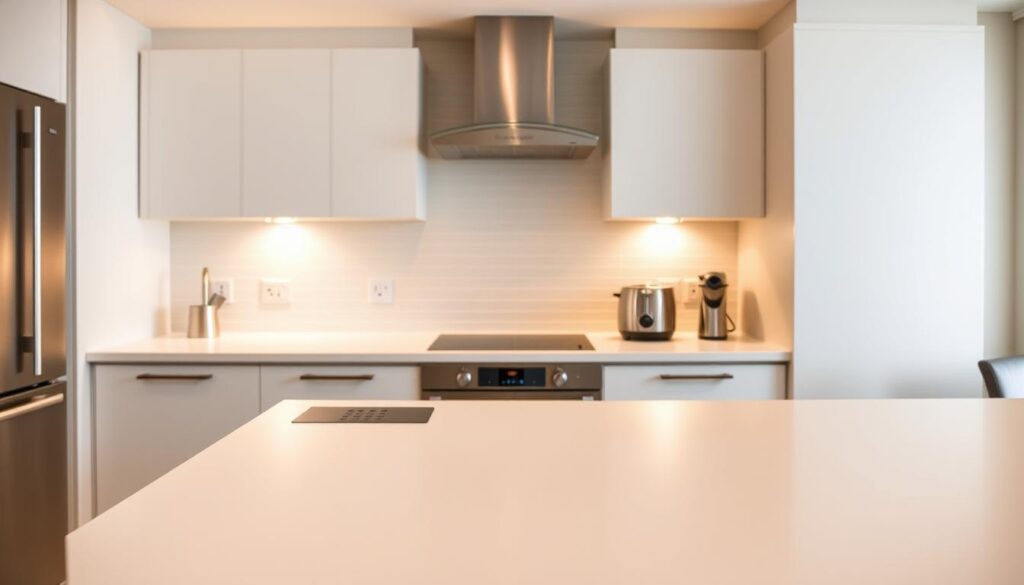
Strategic Placement of Outlets
UK Part P regulations require sockets to be at least 300mm from water sources. Sarah Srinivasan’s hob-side socket demonstrates ideal placement—easily accessible yet safely positioned. Consider these key areas:
- Workstations: Every 1.2m along countertops
- Appliance hubs: Dedicated circuits for high-wattage appliances
- Social zones: USB outlets in breakfast bars
Concealed wiring maintains clean design lines, while surface-mounted options ease future modifications. Always consult a certified electrician to ensure compliance with current standards.
Ensuring Adequate Power Supply
Modern homes demand more power than ever. A typical UK household requires:
| Circuit Type | Minimum Capacity | Typical Appliances |
|---|---|---|
| Lighting | 6A | LED fixtures, under-cabinet lights |
| General sockets | 32A | Small appliances, chargers |
| Dedicated | 40A | Ovens, induction hobs |
Future-proof your design by:
- Installing EV charging points
- Pre-wiring for smart home systems
- Allowing 20% spare capacity for upgrades
“A well-planned electrical system should accommodate tomorrow’s tech as easily as today’s toaster.”
By balancing immediate needs with forward-thinking solutions, your space will maintain its function for decades. Proper planning prevents the frustration of trailing cables and overloaded circuits.
16. Conclusion
Transforming your home in 2025 demands smart planning and expert guidance. Prioritise durable materials, efficient layouts, and professional advice to avoid costly mistakes. Refresh Renovations reports a 92% satisfaction rate among clients who followed structured plans.
Key takeaways for UK homeowners:
- Consult professionals early to align vision with practicality
- Allocate 15-20% of your budget for unexpected costs
- Choose adaptable designs that evolve with your needs
Upcoming building regulation changes emphasise energy efficiency and accessibility. Consider phased upgrades to manage costs while enhancing your space.
Ready to begin? Book a consultation today to create a home that balances style and function for years to come.
FAQ
Why is professional design consultation important for a kitchen renovation?
Professional advice ensures your space is both functional and stylish, avoiding costly mistakes. Experts help optimise layouts, storage, and material choices to suit your needs.
What should I consider when choosing materials for my kitchen?
Prioritise durability alongside aesthetics. Materials like quartz or hardwood offer longevity and require less maintenance, saving you time and money in the long run.
How can I maximise storage in a small kitchen?
Use smart solutions like pull-out shelves, vertical dividers, and multi-functional furniture. Open shelving can also create a sense of space while keeping essentials within reach.
What is the work triangle, and why is it important?
The work triangle connects the sink, cooker, and fridge, ensuring efficient workflow. A well-planned layout reduces unnecessary movement and enhances functionality.
How can I create a realistic budget for my kitchen renovation?
Account for hidden costs like plumbing, electrical work, and permits. Allocate funds for high-quality materials and appliances to avoid future replacements.
What factors should I consider when choosing kitchen appliances?
Match appliances to your lifestyle and cooking habits. Opt for energy-efficient models to reduce utility bills and minimise environmental impact.
How can I achieve balanced lighting in my kitchen?
Combine task, ambient, and accent lighting. Under-cabinet lights improve visibility for cooking, while pendant lights add style and warmth to the space.
Why is ventilation crucial in a kitchen?
Proper ventilation removes odours, grease, and moisture, improving air quality. In open-plan designs, extractor fans prevent smells from spreading to living areas.
What is the ideal depth for a kitchen worktop?
A depth of 60-65 cm is optimal for most tasks. Ensure it complements your cabinetry and provides enough space for food preparation and appliances.
What are the benefits of installing a backsplash?
A backsplash protects walls from spills and splashes while adding a decorative element. Choose materials like glass or ceramic for easy cleaning and durability.
Where should I place the sink and dishwasher for optimal workflow?
Position them near each other to streamline dishwashing. Avoid placing the sink too far from the cooker or fridge to maintain efficiency.
When should I include a kitchen island in my design?
An island works well in larger spaces, providing extra storage, seating, and workspace. Ensure it doesn’t disrupt the work triangle or overcrowd the room.
How can I future-proof my kitchen?
Design with flexibility in mind. Incorporate modular storage, adaptable layouts, and timeless finishes to accommodate changing needs over time.
How do colour and finish impact the longevity of my kitchen?
Neutral tones and durable finishes like matte or satin are timeless and easy to maintain. They also resist wear and tear, keeping your space looking fresh for years.
How should I plan for electrical outlets in my kitchen?
Place outlets strategically near workstations and appliances. Ensure you have enough power supply for modern gadgets and avoid overloading circuits.

